There ought to be strong warnings in place against kittens!
You only need to pick up that fuzzy ball of fur once – maybe it fits perfectly on your outstretched hand. The tiny kitty is as soft and as light as a feather, and fluffier than anything you have ever known; when the little fellow blinks at you with those bright, over-sized eyes and lets out a penetrating “miaoooow” you have already lost. Congratulations! You have just decided to share your life with a cat!
But kittens are still babies and consequently cat babies – just like human babies – have special requirements. In order to ensure that living together with the kitten runs smoothly right from the start, we have put together a few useful tips for you here.
Buying kittens – tips to follow
The burdon of choice: a pure-bred or a real cross-breed? From a recognized breeder or better from a private source?
There are many questions you should mull over before letting yourself get carried away, particularly given the surplus of kittens right after the cat mating season in spring and autumn. You will have to live with the decision for a long time – 15 to 20 years perhaps. So, it’s worth taking time beforehand to decide how you should go about getting an adult cat. This cute little kitty will one day turn into a handsome tomcat or a feisty female feline.
When can kittens be separated from their mother?
Of course, you can hardly wait to finally take the little darling home.
But remember: it is better not to separate a kitten from its family too early on; it should be left in the care of its mother and siblings for as long as possible. Are you looking for an adult cat or a kitten? In case it’s a kitten, the motto is “the longer the better”, since young cats need time to become physically fit and psychologically balanced – it is best to plan this big step for no sooner than the kitten’s 12th week.
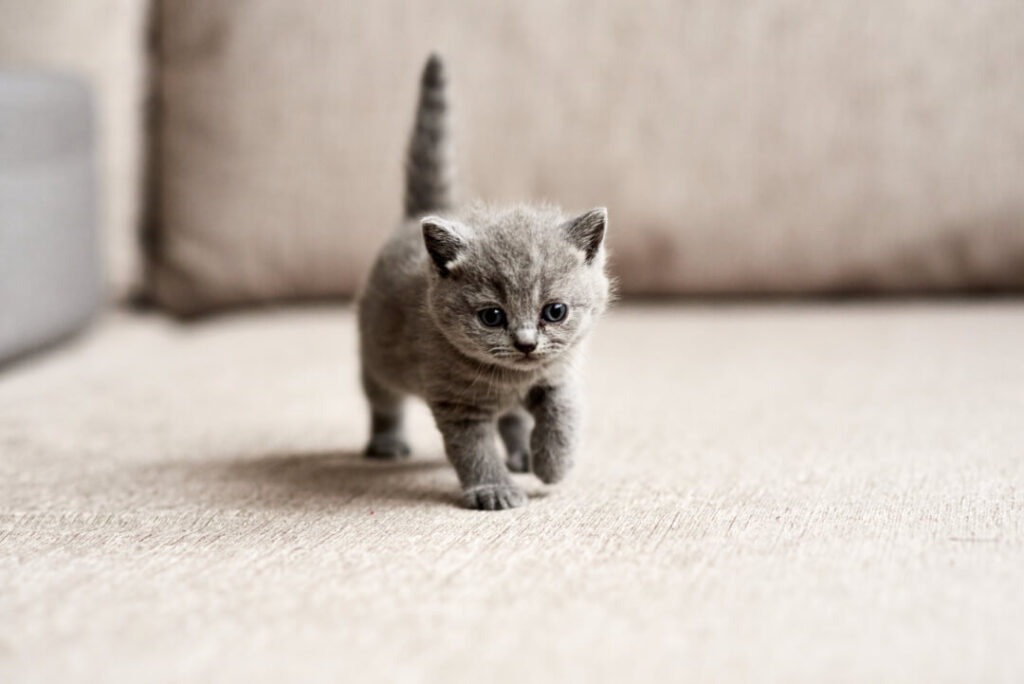
Raising a cat alone or in a pair?
Keeping house cats alone is not ideal – particularly for kittens who are used to living with their family. Just imagine, from one day to the next suddenly no longer having a family and being dropped in a completely new, unfamiliar environment!
OK, so there are plenty of new and interesting things to discover and the giant human strokes and cuddles me, but sometimes I get tired of playing and look for my warm siblings and mum.
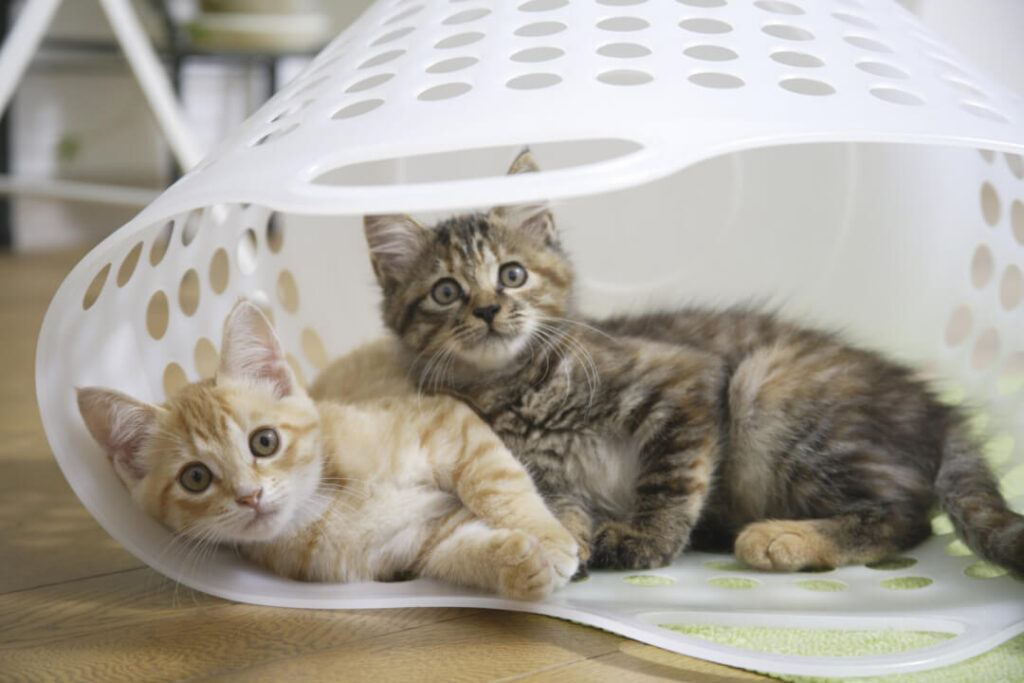
I can only fall asleep when I can cuddle up to them and hear their heartbeat… but they’re just not there. There is only a strange, animal-like housemate who has also hands and feet, but doesn’t smell like a cat at all and yelps when it sees me. Sheer despair!
So, it is best to only get kittens as a twosome!
“Giving away a cat” – 7 points which must be considered
Unfortunately, there are people who at some point feel overburdened when looking after a cat. This has several potential causes, which is why many pets are abandoned, particularly during holiday periods. In the digital age, it has also become incredibly easy to anonymously discard “unwanted” animals in a straightforward manner – much to the outrage of animal lovers and animal rights campaigners!
But what can you do when cats are offered for sale online?
1. Stay calm
Even though it’s hard to understand and you might even feel angry, always stay calm and do not overreact! Otherwise, you won’t be helping the animal. As absurd as it may seem to you, the owner will have their reasons that you should try and accept.
2. Do not make accusations
Do not lecture or try to win over other cat owners. It might make you feel better in the moment and you might have the support of the online community, but the animal will not benefit – to the contrary. Leave the accusations aside and think about how you can help actively and constructively!!
3. Gather evidence
It sounds like a crime film, but it could be the only opportunity to effectively come to the assistance of the animals: if something seems a bit fishy, gather everything you can find about this “case” – including how the supplier communicates with prospective cat buyers.
4. Avoid risk
If your suspicions are confirmed that an animal is being mistreated or is in distress, contact animal protection services or the public order office (Ordnungsamt). According to the German Animal Welfare Act, cats and dogs are “objects”, but they should still not be mistreated and the Ordnungsamt must intervene.
5. Offer assistance
An animal being given away should not necessarily send alarm bells ringing – it may also indicate helplessness or a desperate situation. Is there a way that you can help the animal? Perhaps on a transitional basis until a longer-term solution is found? Do you perhaps know someone looking for a cat?
6. Contact animal protection services
In many cities and municipalities there are animal protection organisations or even those specialised in caring for cats in need; most volunteer animal rights activists take their work very seriously and often look after cats in collaboration with practising vets.
7. Say thanks
Local animal protection services rely on donations: as you can imagine, food and litter as well as vehicle, rental and vet costs need to be paid – it all adds up. Animal protection services pay for the costs of caring for animals out of their own pockets and are happy to receive donations.
Bringing up a baby cat
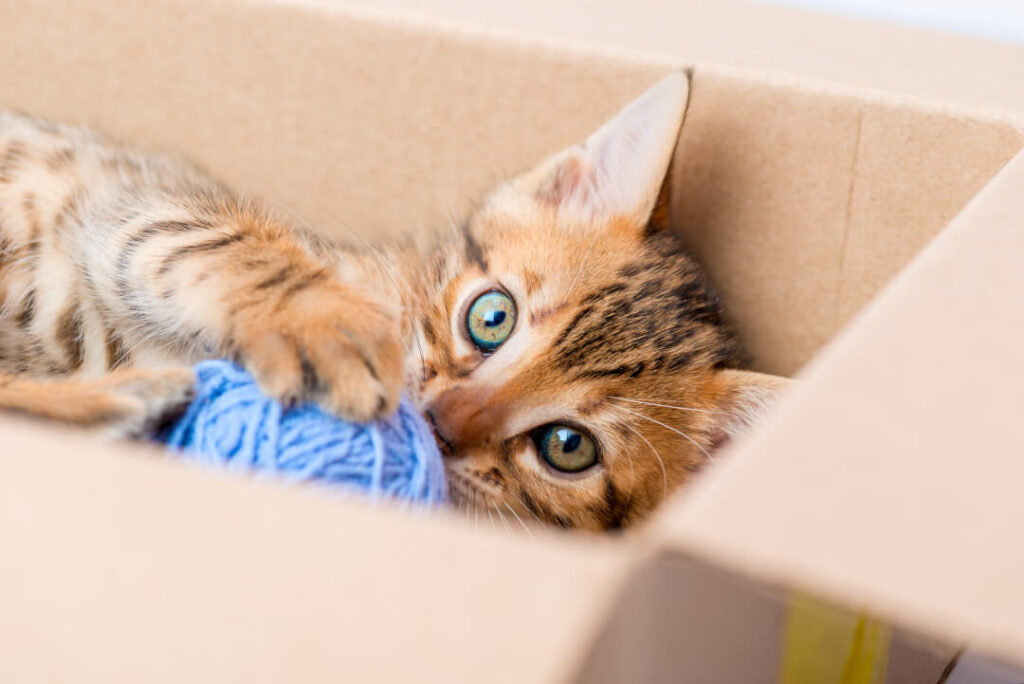
Plan to allow enough time for your little kitten because, just like human babies, kittens need a lot of care and attention. For the kitten, this is the beginning of a new phase in his or her life which will shape the way that living with you is going to be in the future. An exciting time that, every now and then, will present real challenges to both you and the new inhabitant of your house!
The kitten must first of all find its way around in an alien world: everything is new and unfamiliar here – and the little fellow has suddenly been left all on its own. Act sensitively and try to make the transition into the human world as animal-friendly as possible.
The development of kittens
When they come into the world, kittens already have some of their vital reflexes, such as the sucking reflex, though they cannot yet hear or see. However, they do use their sense of smell to reach the teats of their mother. A few days later, the well-known “milk tread” can be observed: the milk flow is gently stimulated by the rhythmic treading of the front paws (incidentally, adult cats also do this when they feel well!). Kittens thus spend most of their time drinking their mother’s milk, sleeping and growing – and rapidly so. Their weight practically doubles in their first week of life!
While your kitten grows and thrives, it undergoes 3 key phases of development:
- During the first and second weeks, your kitten is still entirely dependent on its mother
- From week 3 to week 7, the kitten starts to notice and explore its environment.
- From week 8 to week 24,the kitten’s relationship and bond with you is built and strengthened.
The best place for kittens to sleep
Before you bring the kitten home, you should ensure that you have everything that it needs to feel completely at ease. Basic equipment includes a suitable litter box for kittens, food and water bowls, scratching furniture, cat toys and a quiet place for it to sleep and retreat into, since even the most restistant energy little bundle has to rest once in a while.
Make sure that you put away or dispose of anything that could endanger your kitten. This includes everyday objects such as rubber bands or garbage bags (normally not a problem for “old” and experienced cats) as these can be life-threatening for kittens. Put them away!
What kittens like to play with
The most popular games are always based on their natural instincts: cats are hunters! They like to stalk, lurk and pounce. In addition to cat scratching posts spruced up with an appealing dangling toy, scratch pads where they can hunt scurrying mice are also popular among old and young cats alike. It is much more exciting for your pussycat if you swing the dangling toy yourself, as it creates lots of unexpected turns.
Then there are also the “classics”: small balls or mice – with or without sounds or squeaks! Quick, swift movements create a tremendous amount of excitement. The prey can then be trapped mid-air. It’s a real show! Even the little ones master it perfectly.
Tip: When buying or making toys, think of your nerves – can you stand the constant squeaking?
The cat scratching post as furniture protection
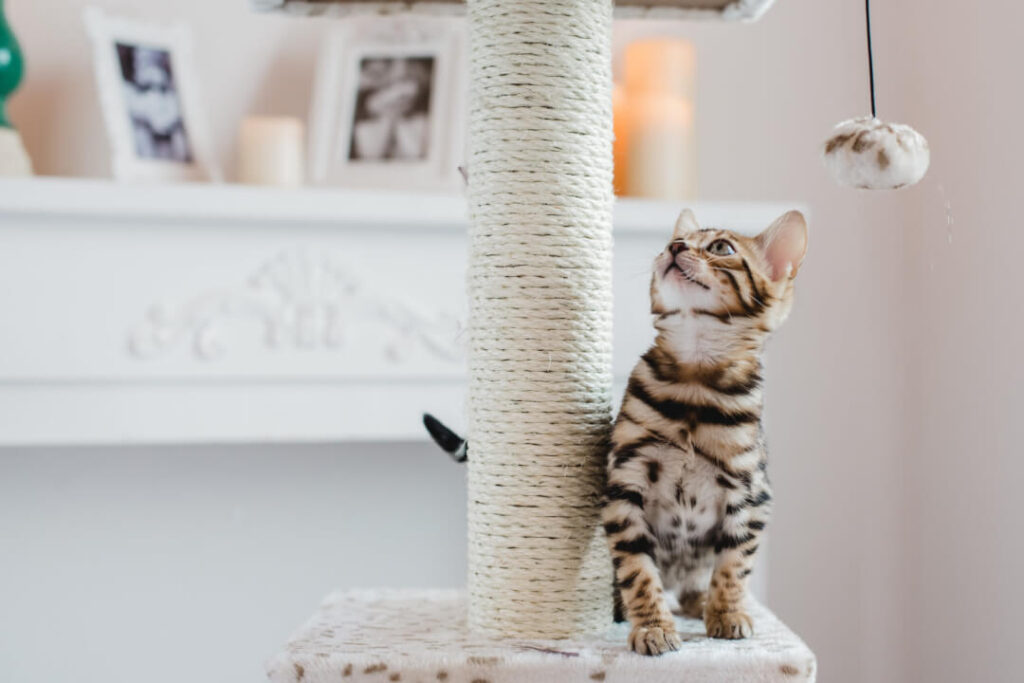
This is a point of contention among cat experts: This is a point of contention among cat experts: should there be a smaller post for kittens or is this not necessary? This certainly depends on the age of the kitten and whether there are other cats in the house as well as other things to scratch. Stable, lower furniture to scratch is appropriate for very small kittens. If the “starter model” is as high as the ceiling, you should make sure that the platforms can also be safely reached by the little kitty. Do everything you can to prevent falls!
Raising kittens: what kittens need to learn
It’s best not to encourage them to do things that, although are amusing at this delicate age, will no longer be cute when they are adults. Sure, little kittens need to try things out, but they should become gently but firmly acquainted with certain rules of living together from, strong Top tip: If you get your cat chipped, the chip number will also be entered on the vaccine h worms – even a sheltered house cat with no outdoor access! Worms, tapeworms, hookworms and roundworms live inside the cat and feed off its blood. For kittens in particular, a worm infestation can have serious health consequences, from the immune system to the entire body. The digestive tract in particular can be so seriously damaged that the kitten will be unable to fully recover. Some worms can be passed on to humans and trigger diseases and infections, making regular deworming an absolute must for every cat owner.
It is also very cumbersome to get your adult cat to give up “undesirable” quirks – cats love routines and they can also be stubborn. Keep in mind that they don’t know any better, and can’t necessarily understand what you want from them all at once – that was never a problem for you before, right?
How to train your cat
1. Cats aren’t dogs!
“Of course”, you must be thinking, “Even kids know that!” But make sure to understand that you cannot train your cat like a dog; it will not work, because cats are innately independent and don’t always easily cooperate.
- Cats do not respond to punishment, only to rewards.
- Opt for short training sessions
- Start training at a young age
- Always let the cat decide when it has had enough.
2. Recognise talents!
Do not try to train your cat to do something that contradicts its nature or character, it will be torture – for both you and your cat. Teach it something that is aligned with its preferences, and build on that. It will be fun for both of you – and its more impressive than any animal trick.
3. An attractive reward
You might be able to fool a dog with praise or a quick pat, but you are probably not going to get anywhere by giving a cat standard dried food. You need to serve up a sought-after delicacy! Not too much though; you should give them limited portions, as even the most exquisite of treats quickly becomes bland if served in excess.
4. Training with a clicker
An aid that can make training easier is a clicker that you can use to reward your cat: the click sound is a recognizable stimulus for your cat to mark success. This way, your kitten will quickly learn the desired behaviour and be promptly rewarded for it, having lots of fun along the way. If you want to train several cats, each cat should get its own clicker, each with an unmistakeable clicking sound. A clicker can be bought at any well stocked pet store.
Keep the toilet and feeding area separate
For one thing, cats would never naturally “do their business” right next to food or where they sleep. Secondly, they are extremely sensitive to smell – they prefer to stay clear of anything with an unpleasant odour. It is best to position the litter box and bowls in separate rooms so as to not irritate your cat. And always keep them clean. – Cat’s Best makes it as easy as a piece of cake!
How to house-train kittens
Kittens from a breeder are often already “clean”. Cats are actually innately clean animals, which means that their mother has already shown them what to do when they “need to go”. The kitten first needs to get its bearings in its new home – where everything is unfamiliar and new. Thus, you will need a great deal of patience – even if things don’t go as planned at the start.
You can help the kittens to keep clean by setting up several litter boxes with a low rim that the kittens can comfortably reach, so that toilet access won’t resemble a steeple race. Always take your kitten to the toilet after playing, eating or sleeping. Out in the wild, cats “do their business” in the soft, loose soil. You can scrape the litter a little yourself with your finger – this arouses their basic instinct. And don’t forget: when they manage to go, remember to stroke eagerly and give them praise!
Can they use the toilet bowl as a cat toilet?
Seems appealing at first, right? Teaching cats to use the “human toilet? That would spare some tiresome cleaning, not to mention the litter!
However, this is anything but humane, since the cat is then forced to betray its own instincts. Cats do not bury their faeces because they are embarrassed or consider it good manners, but rather in order to not leave it uncovered: they would be exposed to their enemies and they would all know where they are lingering. Additionally, other cats and animals can determine the state of its health from its droppings.Ready to mate? Ill? Faeces can be read by experts like a book, as the consistency changes as quickly as health itself – sometimes daily! Besides that, cats do not like to share their toilet, regardless of whether with cats or humans. They want this space for themselves – private and quiet!
Interpreting cat behaviour – the language of your kitten
The little kitten is now living with you and you want to do everything right, but how do you know if the cat feels at ease and if you can tell what it wants? Well, it purrs and miaows – that is pretty clear – but do cats have a “non-verbal” language and do they only communicate some things with their body?
Yes! How?
You can tell how your cat is feeling just from how they position their tail.
- If the tail is vertical, the cat is in a good mood.
- If the tail is between their legs, the cat is nervous and/or unhappy.
- If the tail is slightly bent forwards, the cat wants to play.
- If the tail is beating back and forth, the cat is irritated.
- If the tail is twitching restlessly back and forth, the cat is lurking.
Nudging with the nose is a sign of affection
If your kitten nudges you with its nose, it is a good sign! It means you have conquered its heart and it’s showing affection towards you
Prodding with paws means playtime
If the kitten touches you with its paw, it wants to play with you. It is asking, “So, do you want to play with me?”
Nuzzling can mean different things
Whilst nuzzling – when the cat gently presses its head against you – they are sending a message:
1. Trust
Special pheromones that the cat uses to make its marks. The message is simple: “MINE!” This gesture can appear rather possessive or charming, but – on the other hand, it is also the greatest proof of love: “YOU, you belong to me, and only me!”
(Note: cats that do not nuzzle their humans do still love them! Each cat has a unique character and shows its feelings in its own way, so please don’t be disappointed or confused if your cat acts differently!)
2. Attention
“Hey, you! I’m here!” Some cats simply need attention when they encouragingly press their head against “their” humans. “Could you just stroke me for a bit? Or give me a little treat? Or a little game wouldn’t be a bad idea, how about it?
3. Its own kind
When used towards its own kind, nuzzling is used for communication purposes – provided that they have a friendly relationship, that is! In this case, its furry buddy is joyfully sniffed and “marked”: “you are my friend! Nice to see you!”
4. Territory
We hang name plates on our front doors, whereas outdoor cats zealously spray outdoors in order to mark their territory. House cats like to do it within the walls of their home: they rub zealously themselves against all fixtures – “I live here!”
Vet fees for cats
So, you’ve now got the basic equipment ready: litter box, food, cat toys, cat scratching post and basket. But what happens when your kitten gets sick?
Even the healthiest of cats, who are neither injured nor diseased, should undergo basic immunisation with a vaccination once a year. The cat will be given a general check-up at the same time. External findings of a check-up are just as important as temperature measurements and eye, mouth, heart and lung examinations. If no major interventions or operations are required, the costs should be completely manageable. It also depends on whether it is a house cat or outdoor cat.
But how high are the actual costs? Unfortunately, there is no general answer to this question:
In principle, veterinarians’ regulations do not stipulate standard fees; only the fees for individual treatment steps is specified because the additional costs for medications and consumables can vary widely according to the outcome.
Vaccinating cats: necessary vaccines
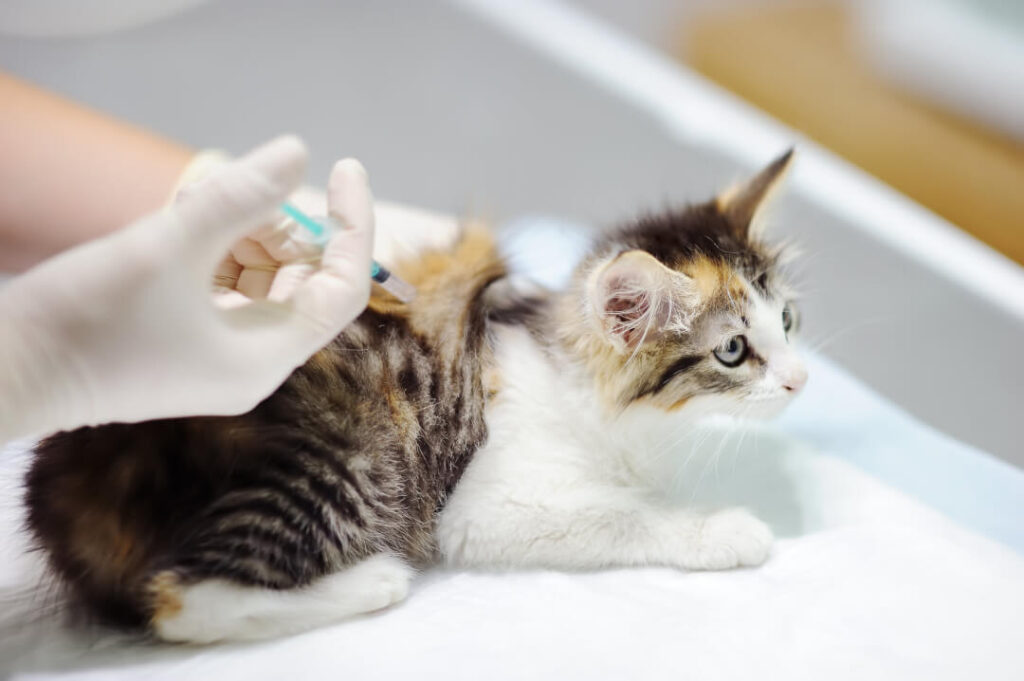
In the kitten’s first week of life, it should receive basic vaccinations. After the 8th week, they should be vaccinated against panleukopenia and cat flu. This basic immunisation is normally topped up after four weeks, and then again after a year.
If you are getting your kitten from a breeder, it will generally have already received the basic vaccines. Outdoor cats should be vaccinated against rabies after the age of 12 weeks.
Other vaccines are also available and can be often provided as single or combined vaccines – just a few pricks and the cat will be protected against a variety of diseases. All vaccines are recorded on your cat’s vaccine certificate: vaccine name, date, and the stamp and signature of the vet. Below are the most common vaccine abbreviations:
- RC (cat flu)
- P (parvovirus, panleukopenia)
- RV (rabies)
- FeLV (feline leukaemia virus)
The German Association of Practising Veterinary Surgeons recommends the following vaccination schedule:
At 8 weeks: RCP
At 12 weeks: RCP + RV + FeLV
At 16 weeks: RCP + RV + FeLV
At 15 months: RCP +RV + FeLV, then in alternation RCP+RV and the following year RCP+RV+FeLV
It is very important because this vaccine certificate is also your cat’s EU pet identity card and passport. You need to present it as proof that your cat has been vaccinated; otherwise you may experience difficulties trying to enter certain countries. Many pet hotels require that you present the vaccine certificate: they need it to prevent furry guests from making each other ill.
Top tip: If you get your cat chipped, the chip number will also be entered on the vaccine certificate. Information on chips can be found below:
Deworming is a must
Any cat can become infested with worms – even a sheltered house cat with no outdoor access! Worms, tapeworms, hookworms and roundworms live inside the cat and feed off its blood. For kittens in particular, a worm infestation can have serious health consequences, from the immune system to the entire body. The digestive tract in particular can be so seriously damaged that the kitten will be unable to fully recover.
Some worms can be passed on to humans and trigger diseases and infections, making regular deworming an absolute must for every cat owner.
- Regular deworming: 1-2 times per year for house cats and once a month for outdoor cat.
- Top priority: hygiene of the litter box
- Cleaningof cat’s sleeping and resting areas
Tip:
- It is best to clean litter boxes with gloves
- Always wash your hands thoroughly after cleaning
- Remove faeces from the litter box as promptly as possible and dispose of the faeces on a daily basis
When should I deworm?
Kittens can be infected with worms by their mother, so deworming at an early stage – preferably at 3 weeks – should be a top priority. It is also advisable to treat cats for worms if they become infested with fleas, as fleas can also transmit worms.
Deworming treatments for cats are available in various forms of administration at the vet: as spot-on, tablet or paste. The dose is tailored to the weight and age of the cat. Tapeworm treatments are available over the counter; special coconut oil which can be mixed into the food is also available without a prescription for prevention. In the event of an acute infection, however, you should definitely visit your vet: they will take a faeces sample and give you the right deworming treatment.
By the way:
as always in life, there are also divergent views on “deworming”. Some absolutely refuse deworming treatments – it is better to regularly check faeces samples and, where necessary, use natural, alternative treatments. Others swear by deworming! If you are unsure, seek the advice of the vet that you trust: they normally know your kitten best from the very beginning!
Get them used to the cat carrier at an early stage
It is best to start getting your kitten used to the cat carrier so it will be less stressful for you both when you need it. Ensure that the box is practical and easy to clean: it should have several openings that are big enough to allow plenty of space for an adult cat later on. Carriers that can be completely opened in the middle are perfect, as you can simply lift the cat out. For the most part, natural materials are better suited to cats; however, when it comes to the carrier it is preferable to get one made of plastic as they are easier to clean should your cat need to relieve itself. They should have a high-quality finish and have no sharp corners or edges, as these could injure the kitten.
Tip: Place something absorbent, such as training pads for puppies or kittens, under the blanket. Training pads are available in a variety of sizes and they are perfect for use in the carrier! The pads are quick to absorb and stay nice and dry.
Do not put the carrier in the cellar or in the attic, instead make it a fixed part of the cat’s life as much as possible– a piece of furniture that the kitten is happy to visit without negative connotations. Inside, place a treasured toy or their favourite blanket that smells just like them.
Caution should be exercised with synthetic “attractants” – this can quickly backfire. This new cave also gets interesting when a tasty treat is placed inside every now and then! It is always worth passing by to take a look. And who knows, one day it might be so inviting that your kitty retreats there for a little nap. Anything can happen when you are patient and don’t pressure them.. Always remember: a cat that is reluctant to be placed in a carrier – possibly under time constraints – will turn into a terror!
So, you have been warned! Now you are ready for a little kitten to enter your home. There are now no more obstacles in the way of domestic bliss! Now you just need to go out and get your cat!
Be patient – kitties are great! We wish you many unforgettable moments together.
